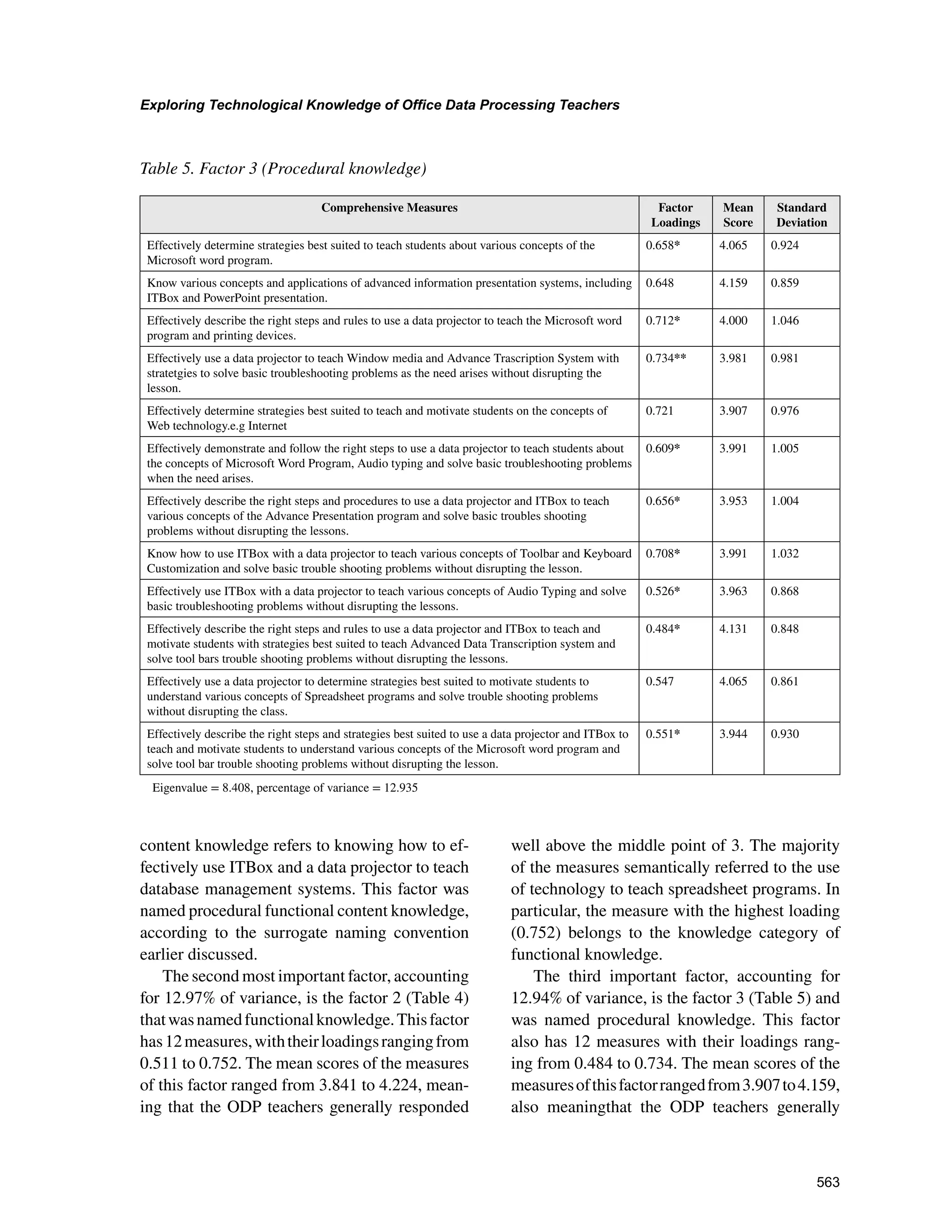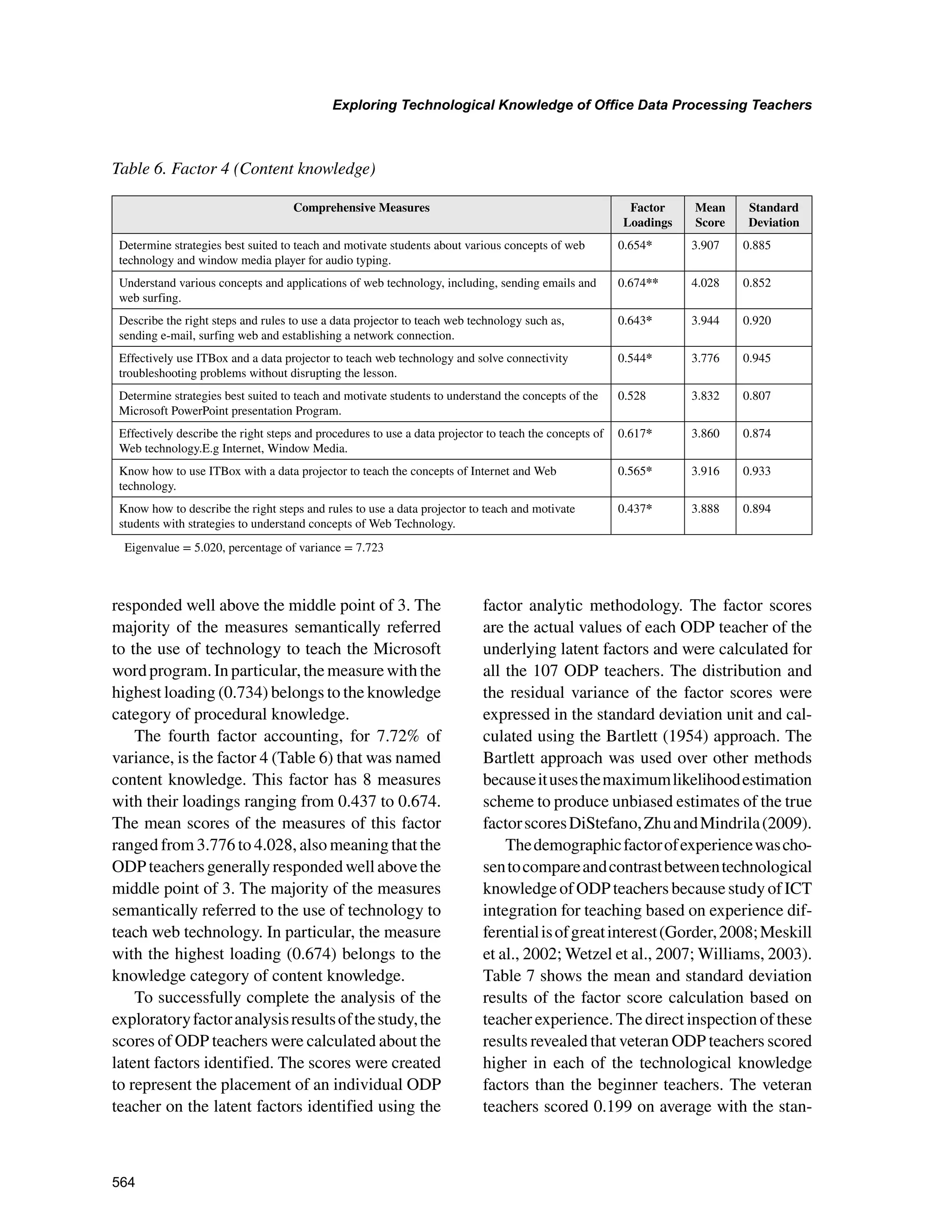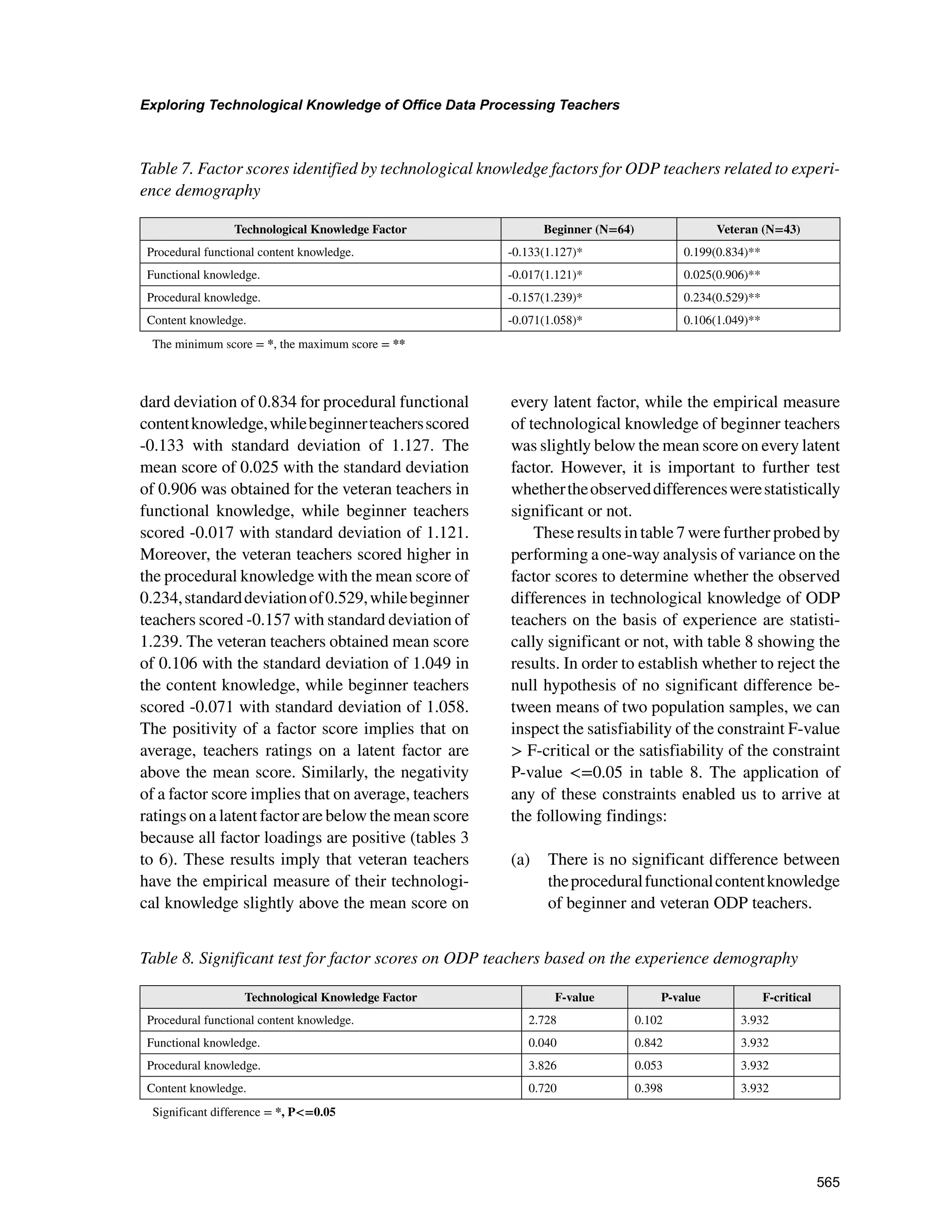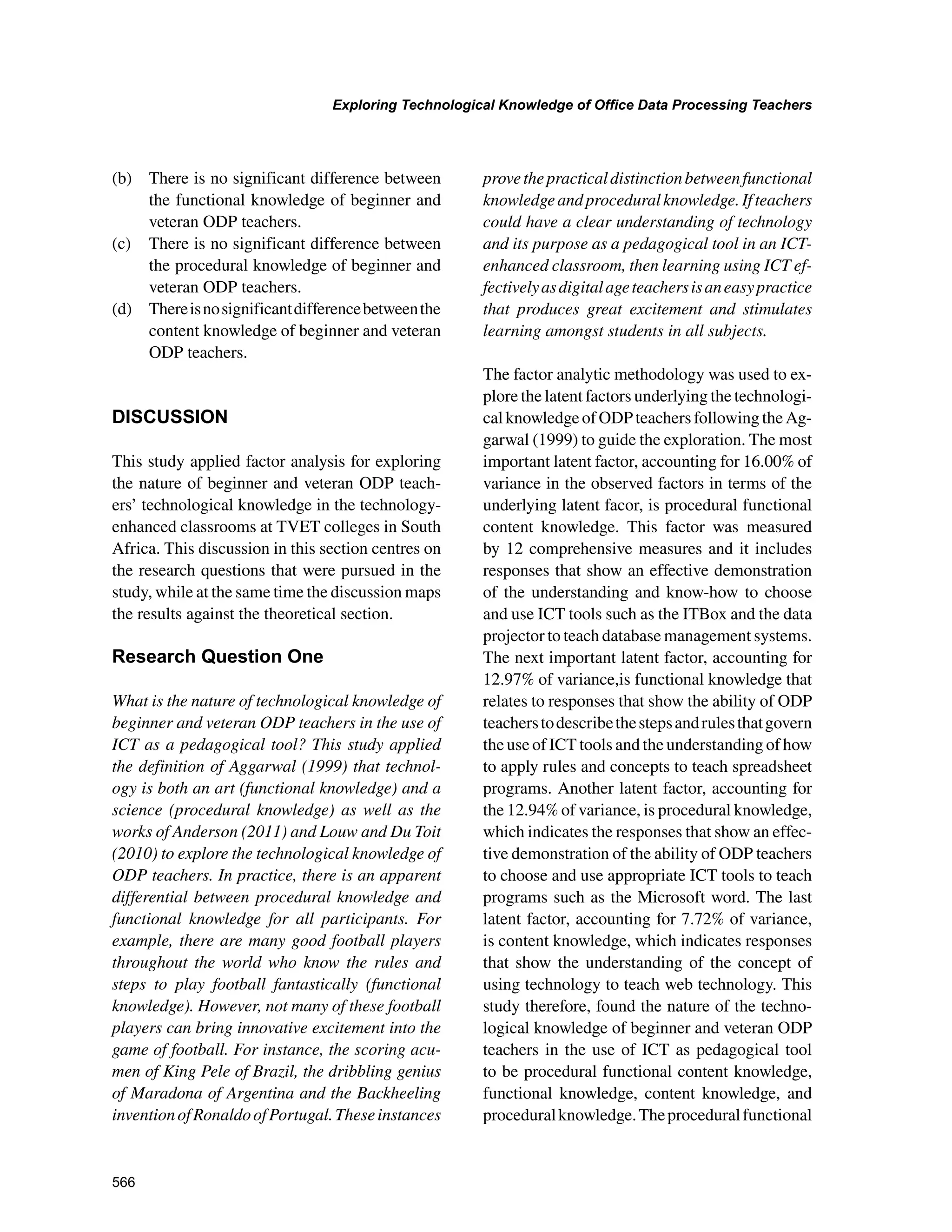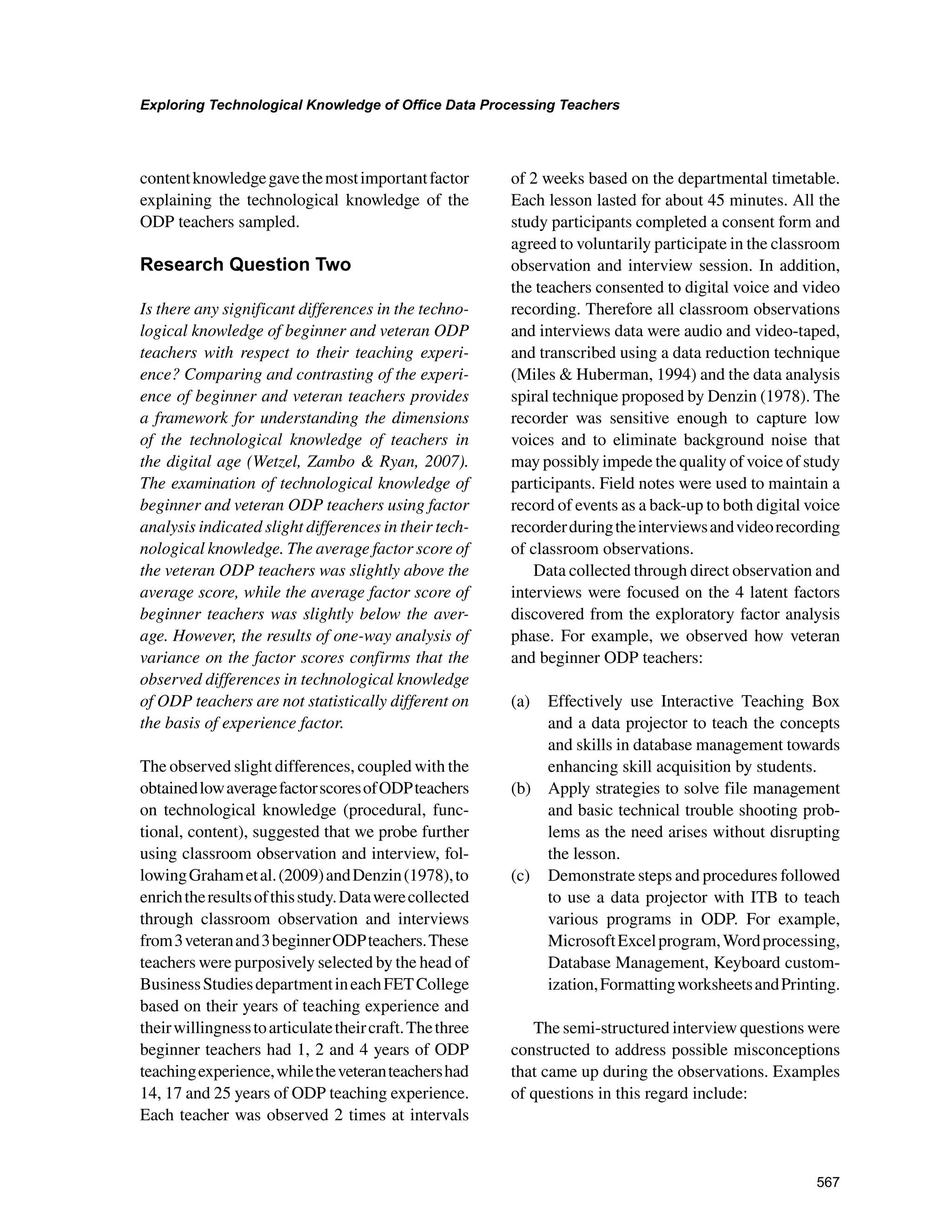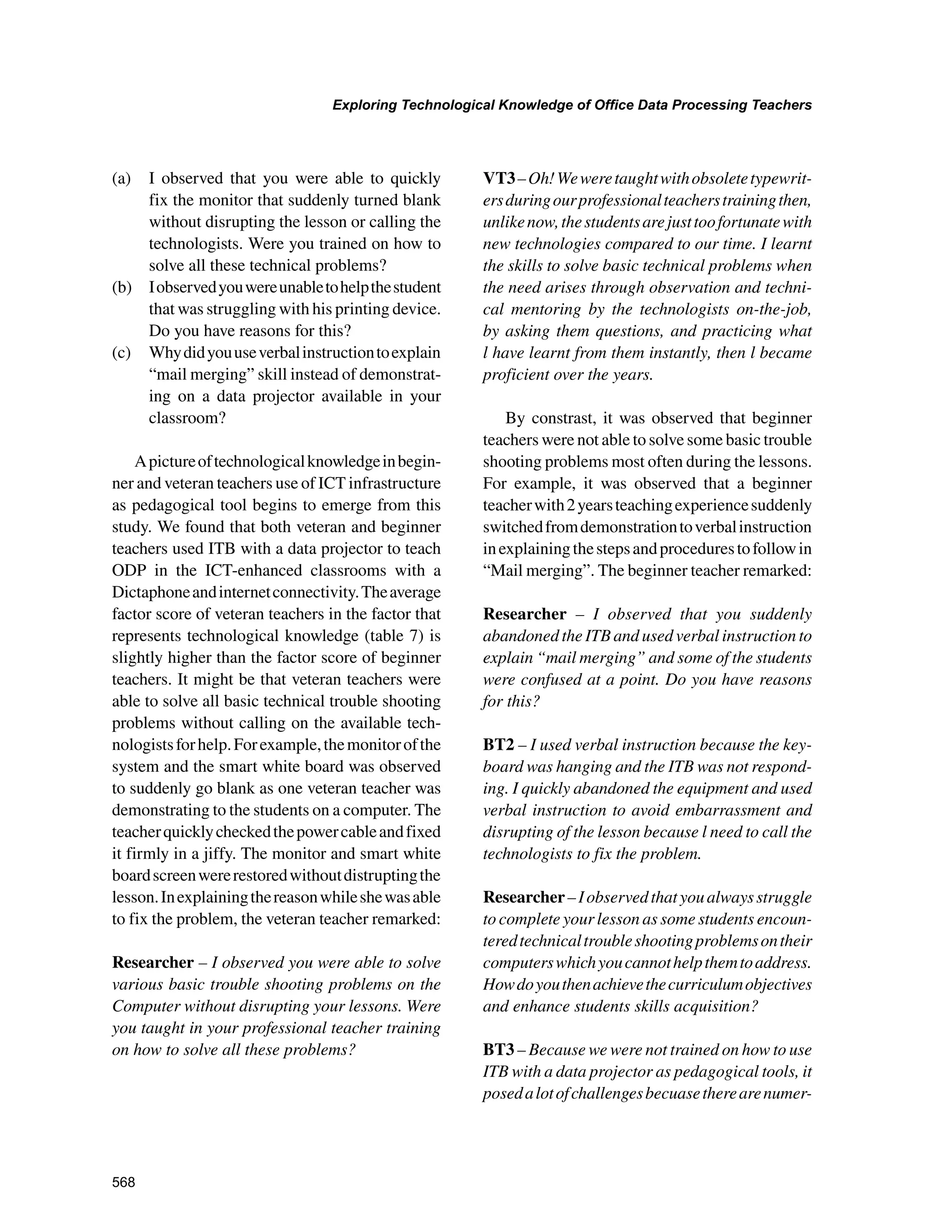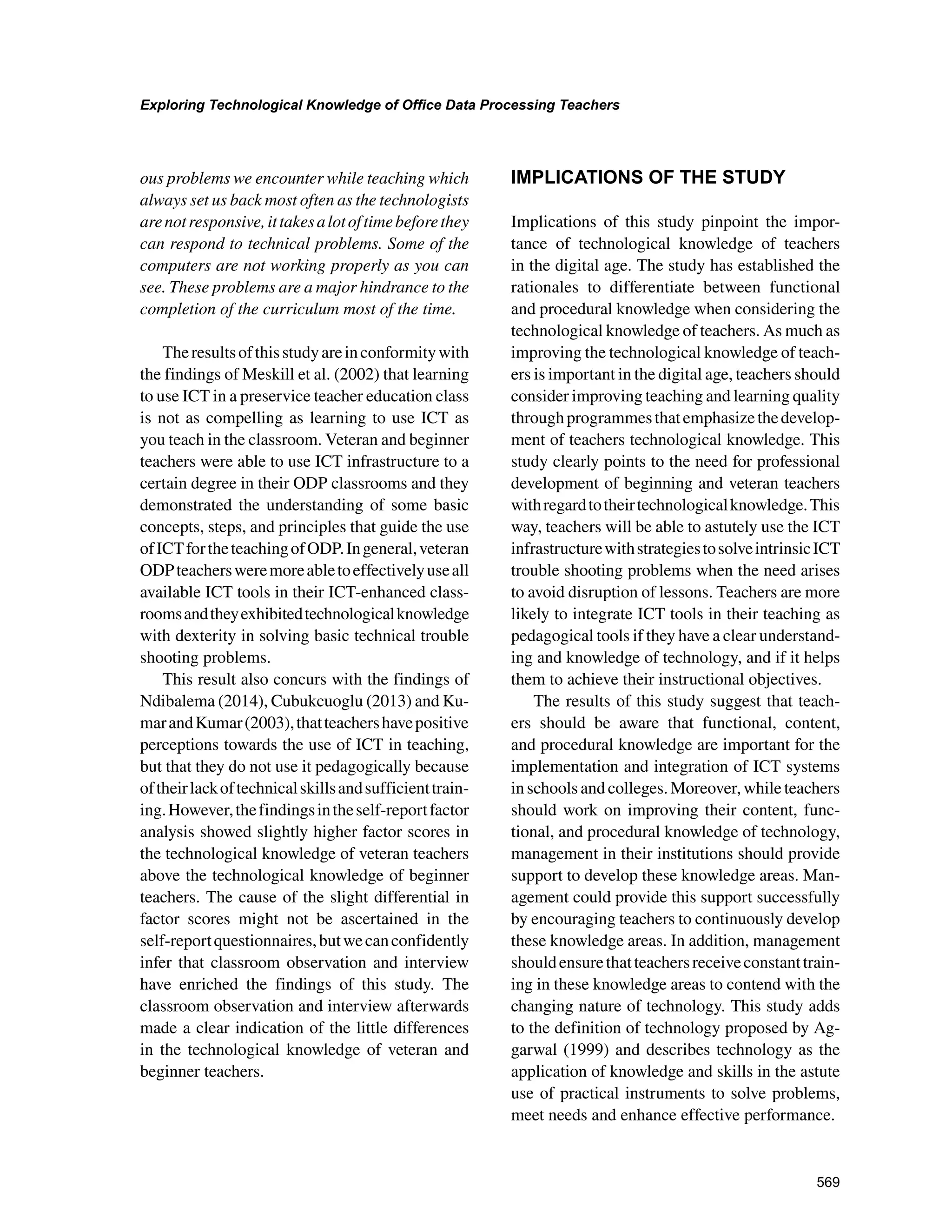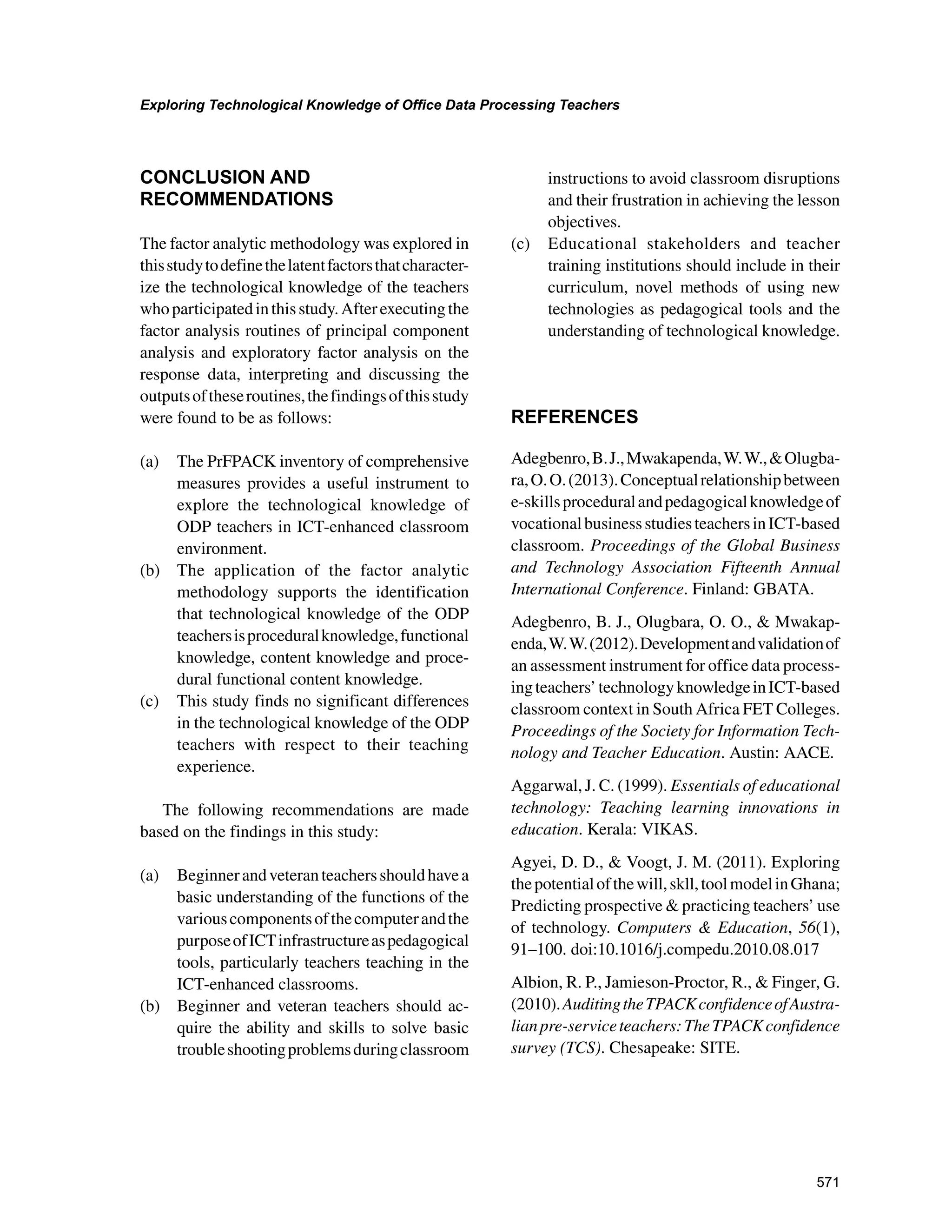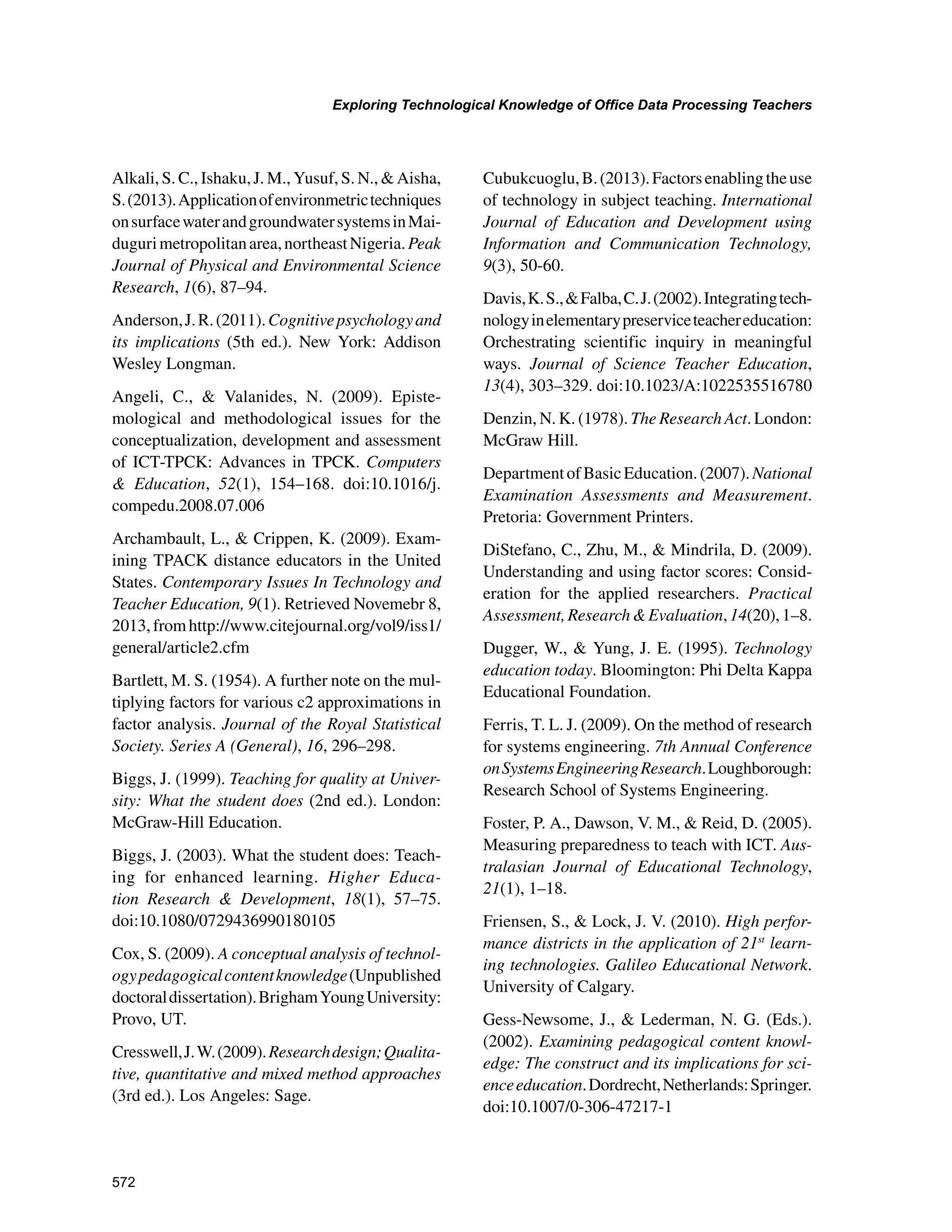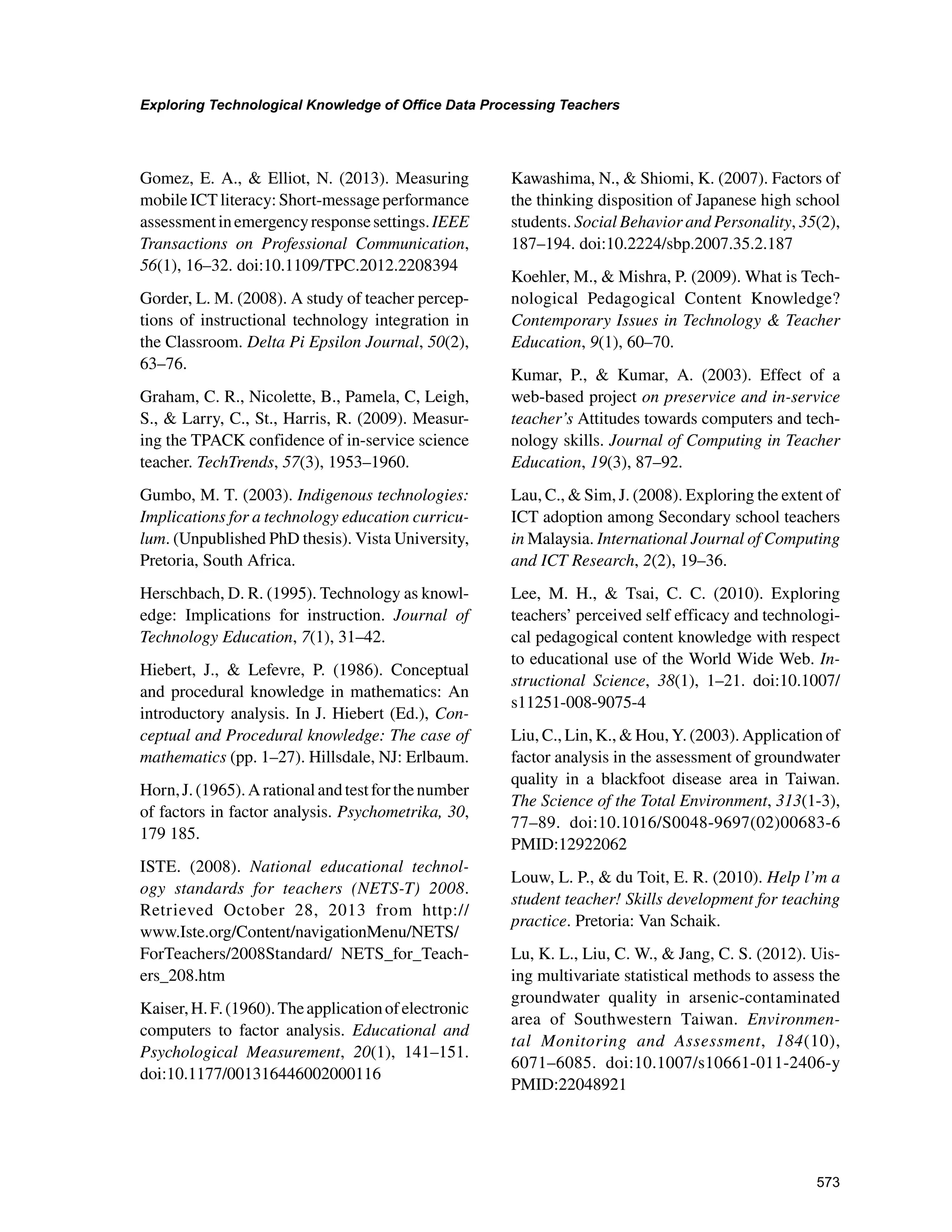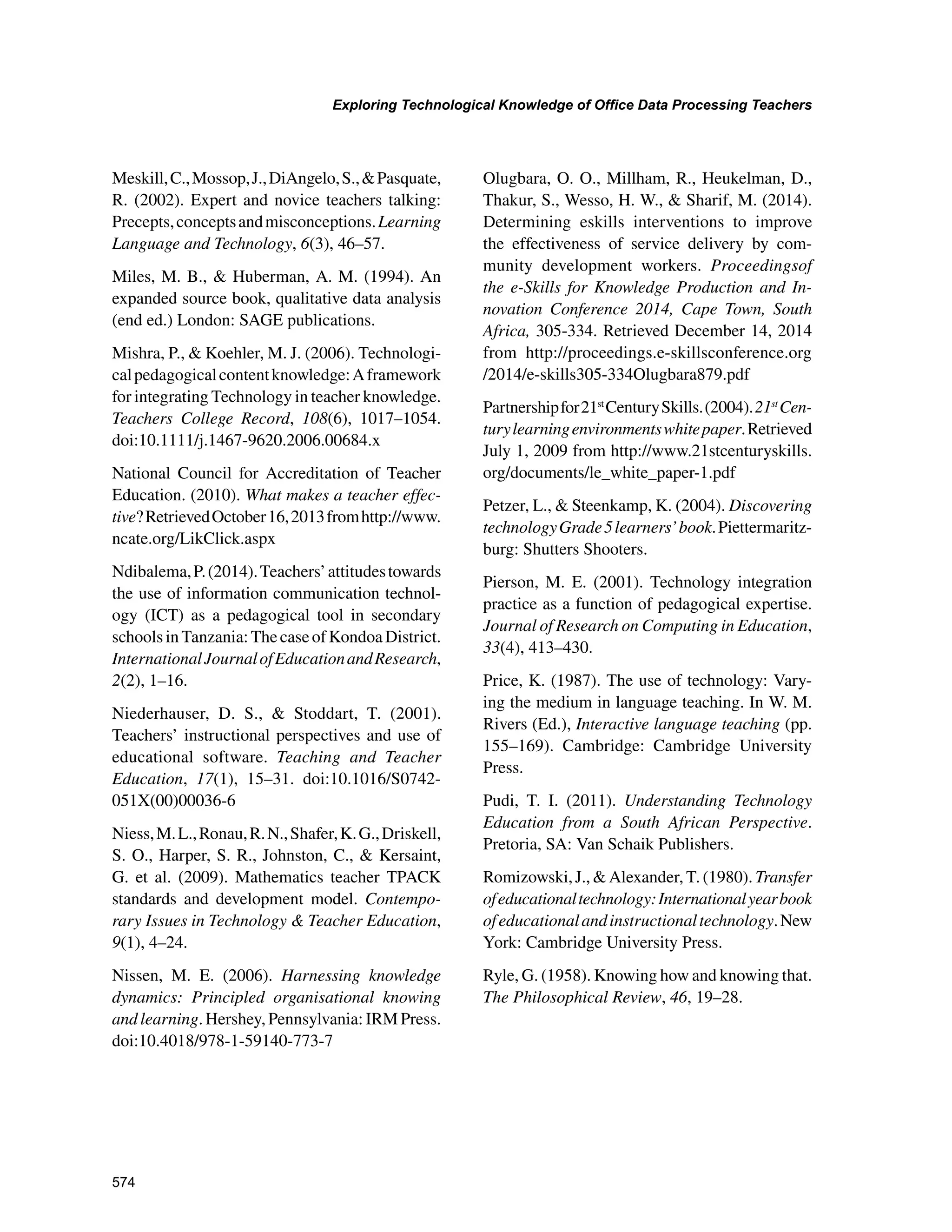This study used factor analysis to explore the technological knowledge of beginner and veteran Office Data Processing (ODP) teachers at colleges in South Africa. The researchers developed a survey based on the Procedural Functional Pedagogical Content Knowledge (PrFPACK) framework, which is an extension of the Technological Pedagogical Content Knowledge (TPACK) framework. The survey collected data on teachers' knowledge of technologies like Microsoft Office, presentation software, and data projectors. The findings revealed that procedural functional content knowledge was the most important factor for ODP teachers' technological knowledge. The study provides insight into the technological knowledge required by teachers in technology-focused subjects.
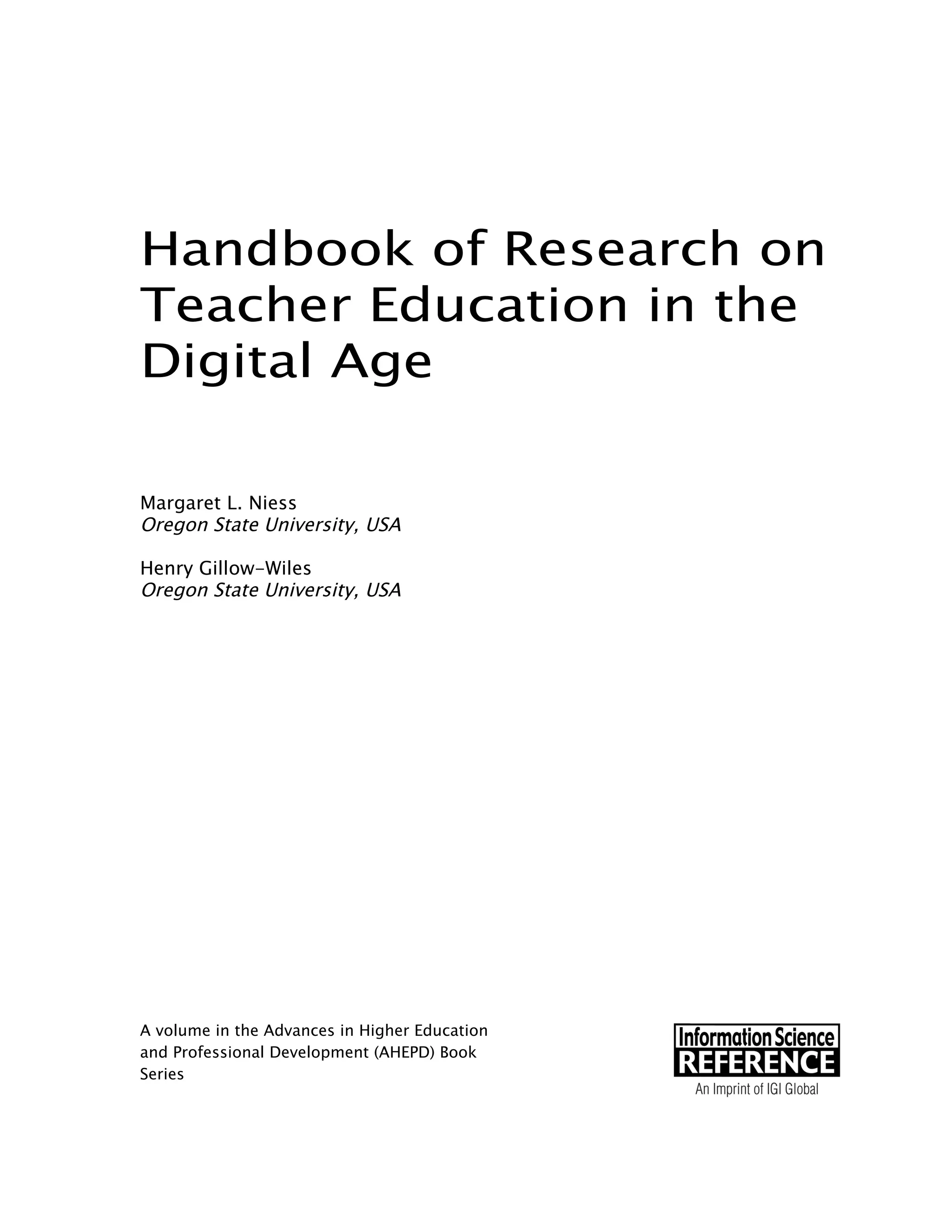
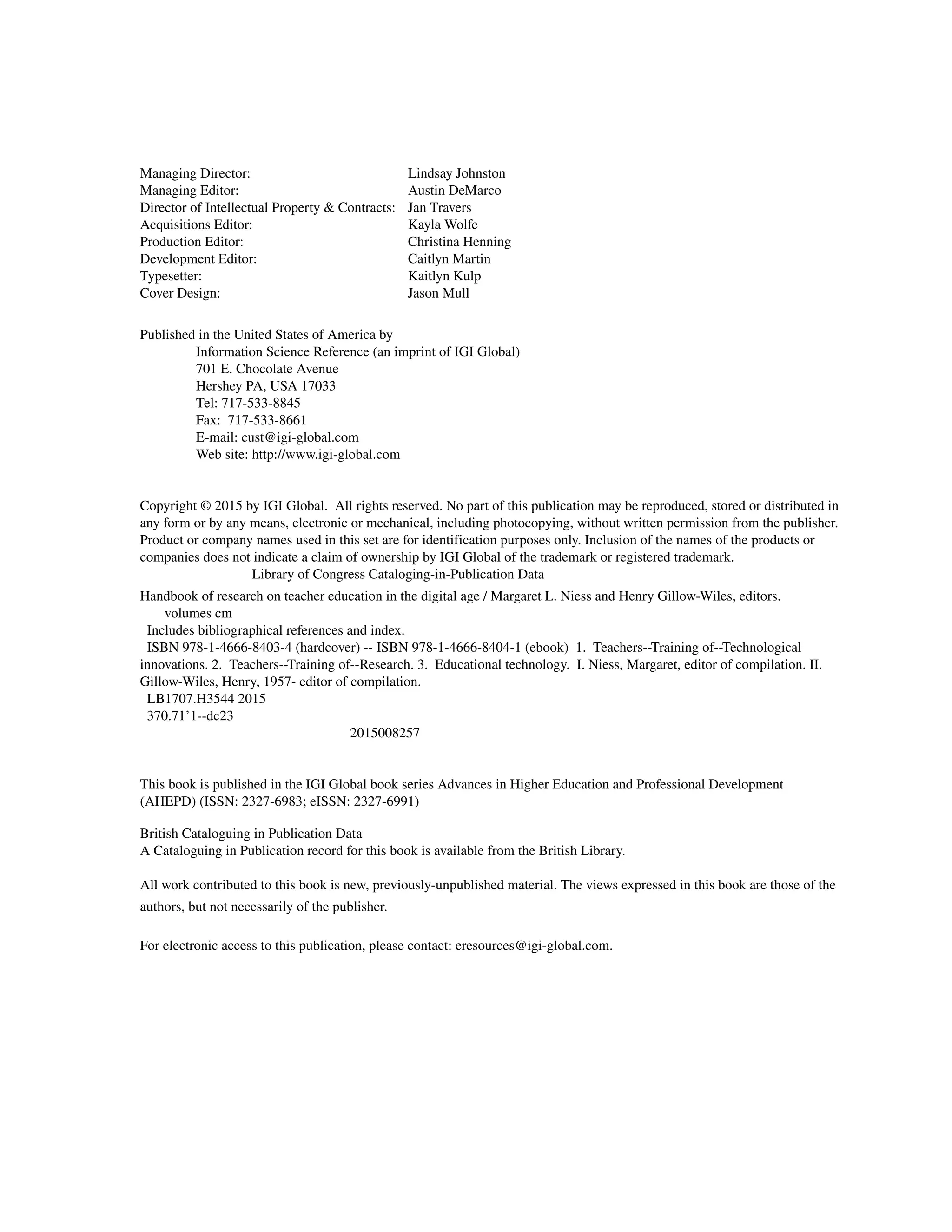
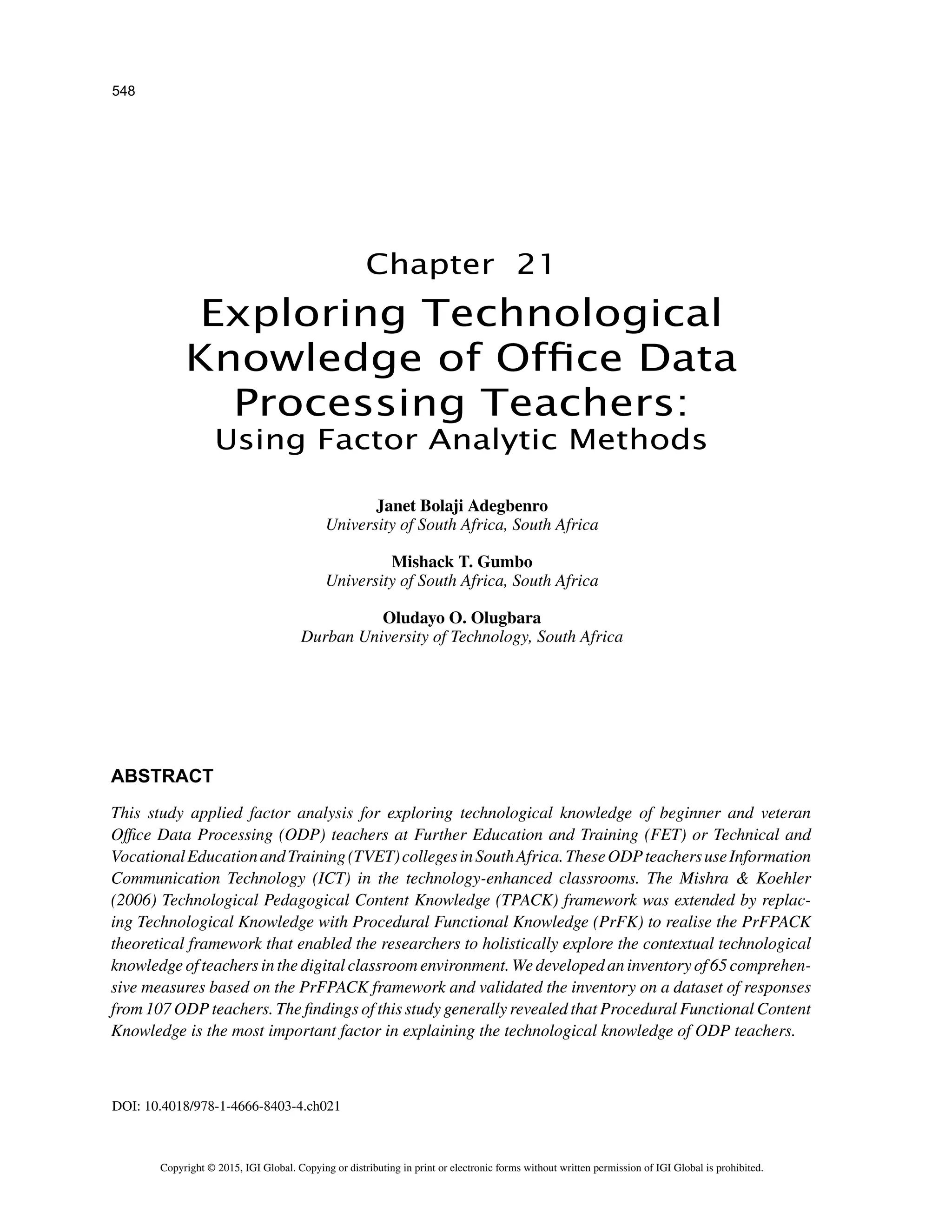
![549
Exploring Technological Knowledge of Office Data Processing Teachers
INTRODUCTION
Helping beginner and veteran teachers develop
technological knowledge and skills in how to use
new technologies to teach is a critical component
ofteacherpreparationinthisdigitalage(National
Council for Accreditation of Teacher Education
[NCATE], 2010). Existing research indicates that
a critical factor influencing beginner teachers’
adoption of technology is the quantity and qual-
ity of technological knowledge and experiences
includedintheirteachereducationprogram(Agyei
Voogt, 2011; Tondeur, Van Braak, Sang, Fisser
Ottenbreit-Leftwich, 2012). Today’s teachers
shoulddeveloplessonsthatteachlearnerscontent
knowledgeandassistthemtodeveloptwenty-first
century skills so that they can think effectively,
actively solve problems, and be digitally literate.
Thepreparationofteachersintheeducationaluses
of technology in the current digital age appears
to be a key component in almost every improve-
ment plan for education and educational reform
program (Davis Falba, 2002). According to
Gess-Newsome Lederman (2003), while some
issuesineducationtakeontheflavorofsocialand
historical context, others, such as how to prepare
beginner and experienced teachers to integrate
technology for effective teaching and learning in
the current digital age, remain almost ill-defined.
Mostimportantly,researchevidenceshowsthatin
spite of many efforts that researchers and educa-
tional institutions have invested over the years in
preparingbothbeginnerandexperiencedteachers
in the educational uses of technology, pre-service
(beginner in this study) and in-service (veteran in
thisstudy)teachersstilllackappropriateskillsand
knowledge needed to be able to successfully use
technology to teach (Uwameiye Adegbenro,
2007). According to Meskill, Mossop, DiAngelo
Pasquate(2002),thisisnotnecessarilythecase,
finding that new teachers appear to be affected by
the existing culture of the teaching profession.
While beginner teachers may be more conversant
with technology in their daily lives than veteran
teachers, they are not exposed to ideas about how
to integrate technology in classroom settings.
Althoughsomeresearchreportedthatteachers’
experience in teaching did not influence their use
of information communication technology (ICT)
in teaching (Niederhauser Stoddart, 2001),
more research showed that teaching experience
influenced the successful use of ICT in class-
rooms (Williams, 2003; Gorder, 2008; Cubuk-
cuoglu, 2013; Ndibalema, 2014). In particular,
Gorder (2008) reported that teacher experience
is significantly correlated with the actual use
of technology. Lau and Sim (2008) conducted a
study on the extent of ICT adoption among 250
secondaryschoolteachersinMalaysia.Theirfind-
ingsrevealedthatexperiencedteachersfrequently
use computer technology in the classrooms more
than the beginner teachers. This result implies
that teachers’ ICT knowledge and skills in rela-
tion to the successful implementation of ICT as
pedagogical tool (Pierson, 2001) is complex and
not a clear predictor of ICT integration in teach-
ing and learning. In addition, Kumar Kumar
(2003) argue that lack of adequate training and
experienceisoneofthemainfactorswhyteachers
do not use technology in their teaching.
The Further Education and Training (FET)
colleges in South Africa currently have greater
access to educational technologies than has
been the case in the past. In addition, much
investment has been made in the acquisition
of ICT infrastructure in these colleges where
vocational and technology-based subjects are
being offered for the purpose of artisan skills
development.However,verylittleisknownabout
whatformsoftechnologicalknowledgeandskills
are needed by Office Data Processing (ODP)
teachers for effective teaching and learning. It
is in this sense that in this study we explored
the technological knowledge of ODP teachers
at FET colleges in South Africa. We explored
the technological knowledge of ODP teachers](https://image.slidesharecdn.com/9fa76cad-d82e-4899-af61-921f328b50bc-170203105159/75/Exploring-Technological-Knowledge-of-Office-Data-Processing-Teachers_-Using-Factor-Analytic-Methods-4-2048.jpg)
![550
Exploring Technological Knowledge of Office Data Processing Teachers
in the specific domains such as Microsoft Word
program, spreadsheet application, audio typing,
PowerPoint presentation, Interactive Teaching
Box (ITB), Web technology, and data projector
application. The teaching of these applications
in FET colleges is in line with the new South
Africa’s National Certificate Vocational (NCV)
curriculum standard and the ICT White Paper
Policy of the Department of Basic Education
(2007). Moreover, ODP requires a particular
procedure and a set of tasks that should be ex-
ecuted within a given period of time.
This study promises to contribute towards a
better understanding of the framework that can
be used to unpack the technological knowledge
of teachers. A framework for understanding
and unpacking the knowledge of teachers who
teach with the help of technology needs to have
a technology dimension. The overarching re-
search questions that we pursued in this study
are enunciated as follows:
(a) What is the nature of technological knowl-
edge of beginner and veteran ODP teachers
in the use of ICT as a pedagogical tool?
(b) Is there any significant differences in the
technological knowledge between beginner
and veteran ODP teachers with respect to
their teaching experience?
We proceed by giving the background of the
study in the next section to examine the techno-
logicalpedagogicalcontentknowledge(TPACK)
framework that undergirds this study, explain
technologicalknowledge,andexaminetheProce-
duralFunctionalPedagogicalContentKnowledge
(PrFPACK) framework. These literature review
sections are followed by the discussion of the
chosen methodology, and the presentation and
discussion of findings.
BACKGROUND
The knowledge related to the effective use of
educational technologies has become widely
recognizedasanimportantaspectofaknowledge
baseofeducatorsinthedigitalage(ISTE[Institute
for Science and Technology Education], 2008;
NCATE,2010;Partnershipfor21st
CenturySkills,
2003). The concept of knowledge as applied to
Science,EngineeringandTechnology(SET)cov-
ersdeclarativeknowledge(knowthat),functional
knowledge(know-how)andproceduralknowledge
(skills) (Ferris, 2009; Nissen, 2006). Most of the
literature discussing different types of knowledge
of teaching and learning dwells extensively on
cognitive and affective domains of knowledge
Shulman(1986)andBiggs(1999).Thesetypesof
knowledgeareoftenassociatedwithsurfacelearn-
ing concerning the representation of facts rather
than assimilation of the significance of the facts
into a construct that guides an appropriate action
(procedural knowledge). The essential types of
knowledgethatcanenhanceeffectiveteachingand
learninginanICT-enhancedclassroomhavebeen
identified in the literature to include pedagogical,
declarative,functionalandproceduralknowledge
as applied to SET (Nissen, 2006).
Pedagogicalknowledgereferstotheknowledge
of methods and strategies employed by teachers
in the process of teaching and learning. This
knowledge includes the fundamental knowledge
of classroom management, sequential lesson
preparation, student motivation, assessment and
evaluation. Declarative knowledge is defined by
Ryle (1958) as “know that”, which is a form of
knowledge that is associated with representa-
tions of facts rather than assimilation of facts
into constructs that guide effective actions. Some
researchers also refer to this concept as content
knowledge (Shulman, 1986;Shavelson, Ruiz-
Primo, Li Ayala, 2003).
Functional knowledge is defined by Ryle
(1958) as “know-how”, or having the ability to](https://image.slidesharecdn.com/9fa76cad-d82e-4899-af61-921f328b50bc-170203105159/75/Exploring-Technological-Knowledge-of-Office-Data-Processing-Teachers_-Using-Factor-Analytic-Methods-5-2048.jpg)
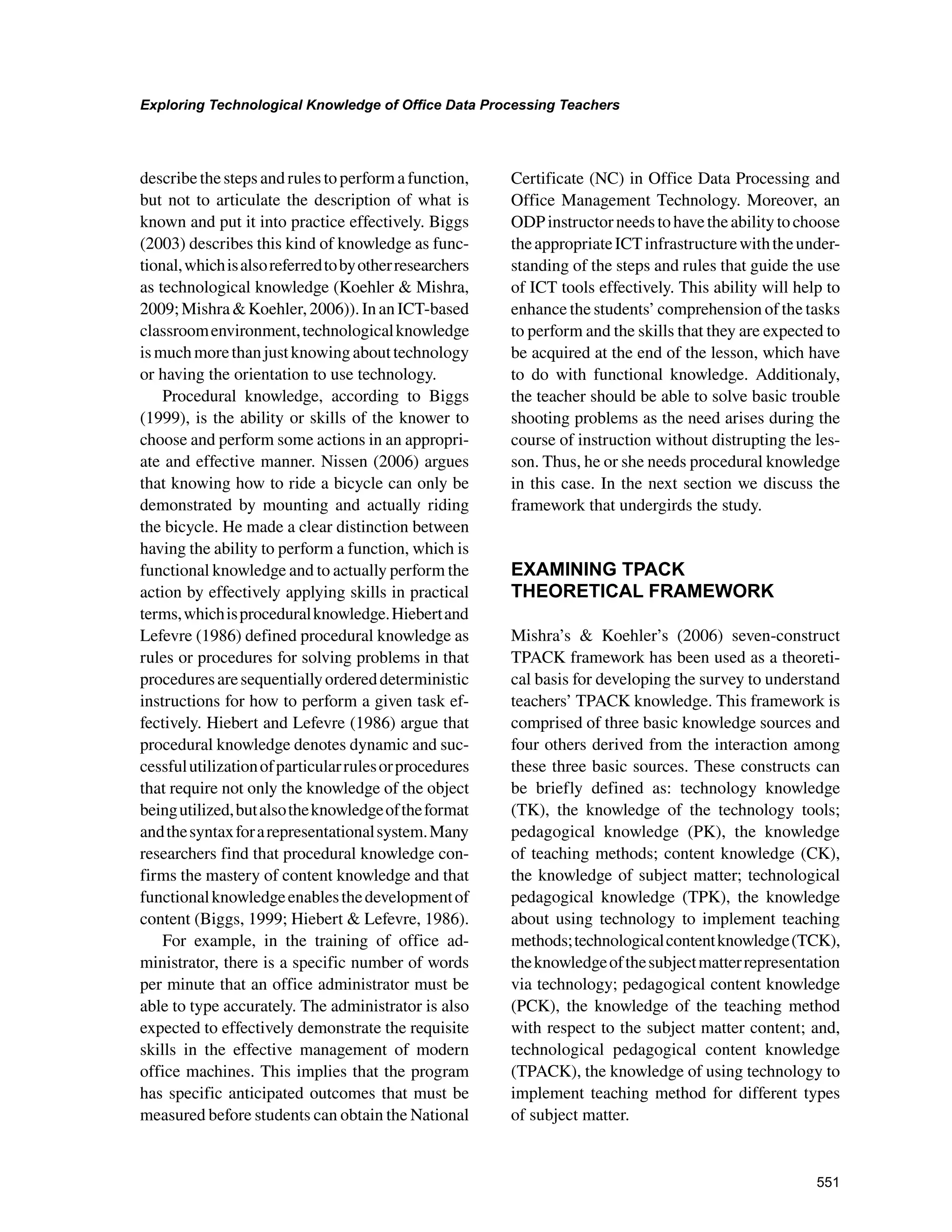

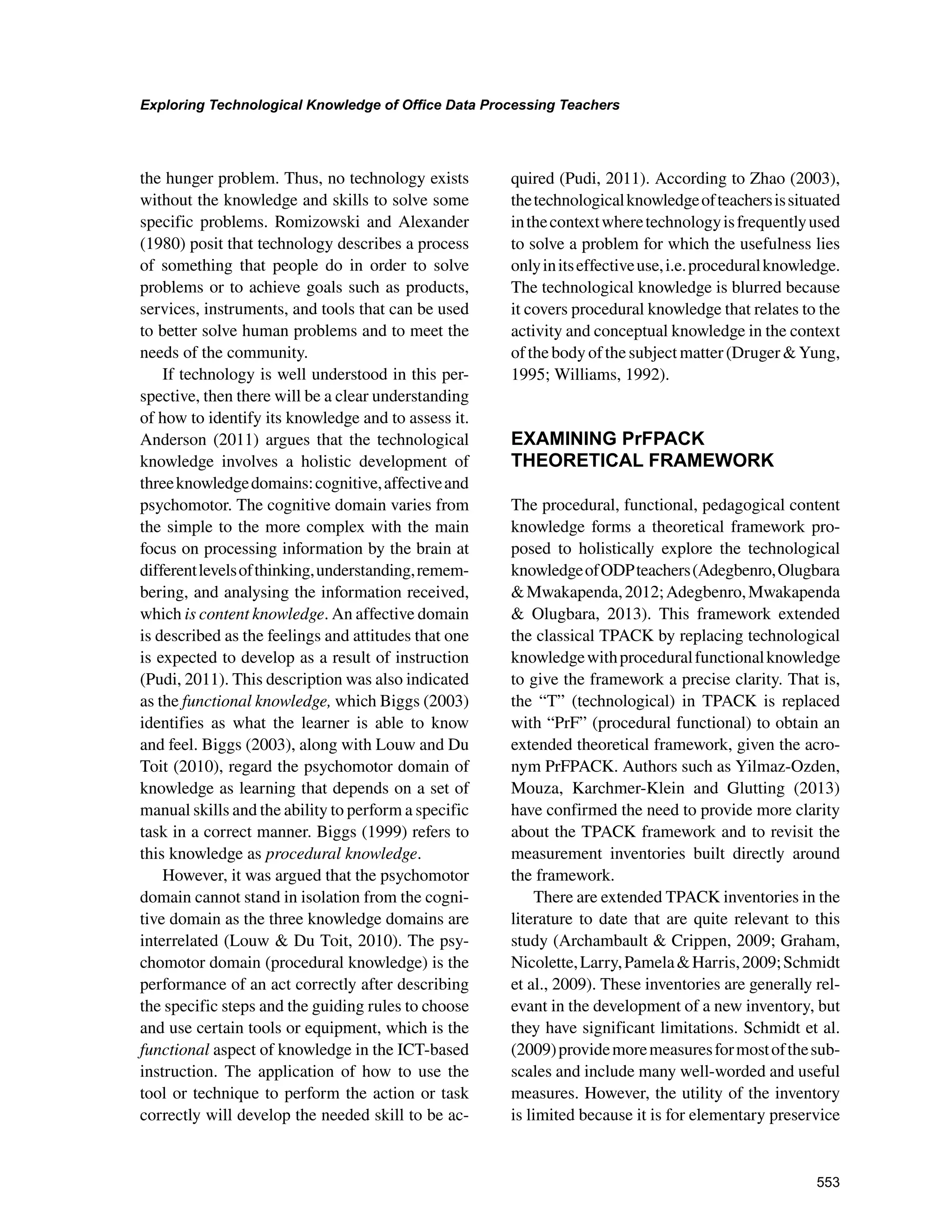
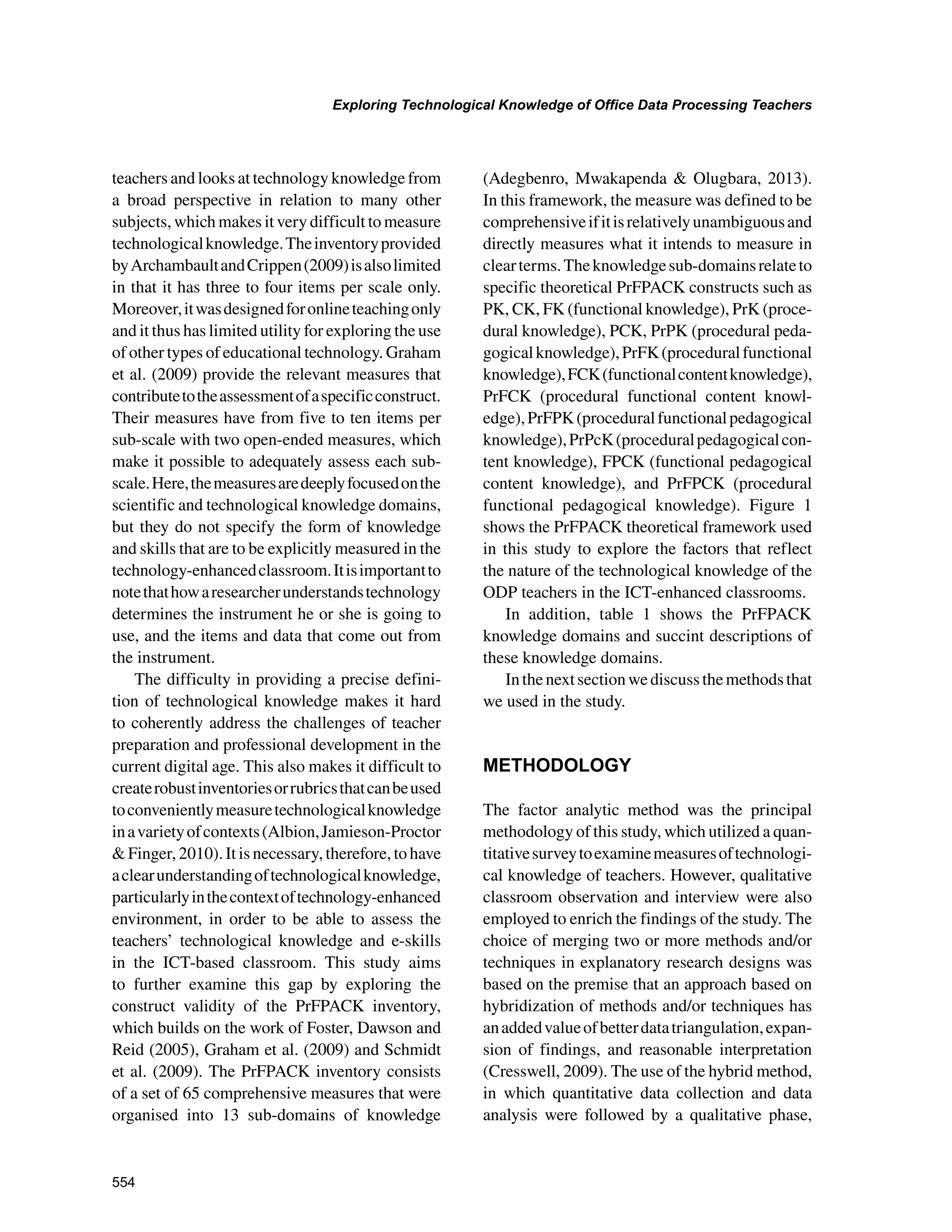

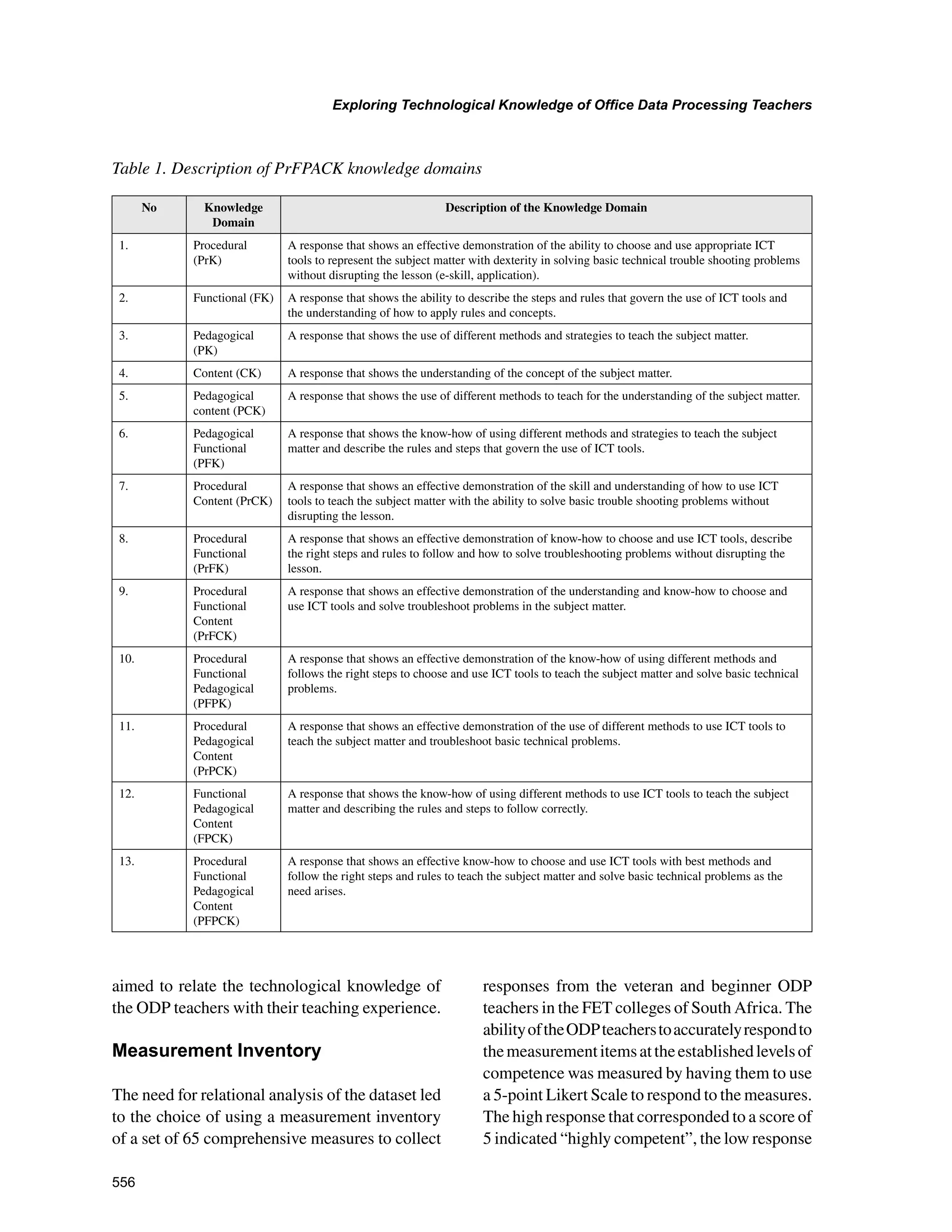
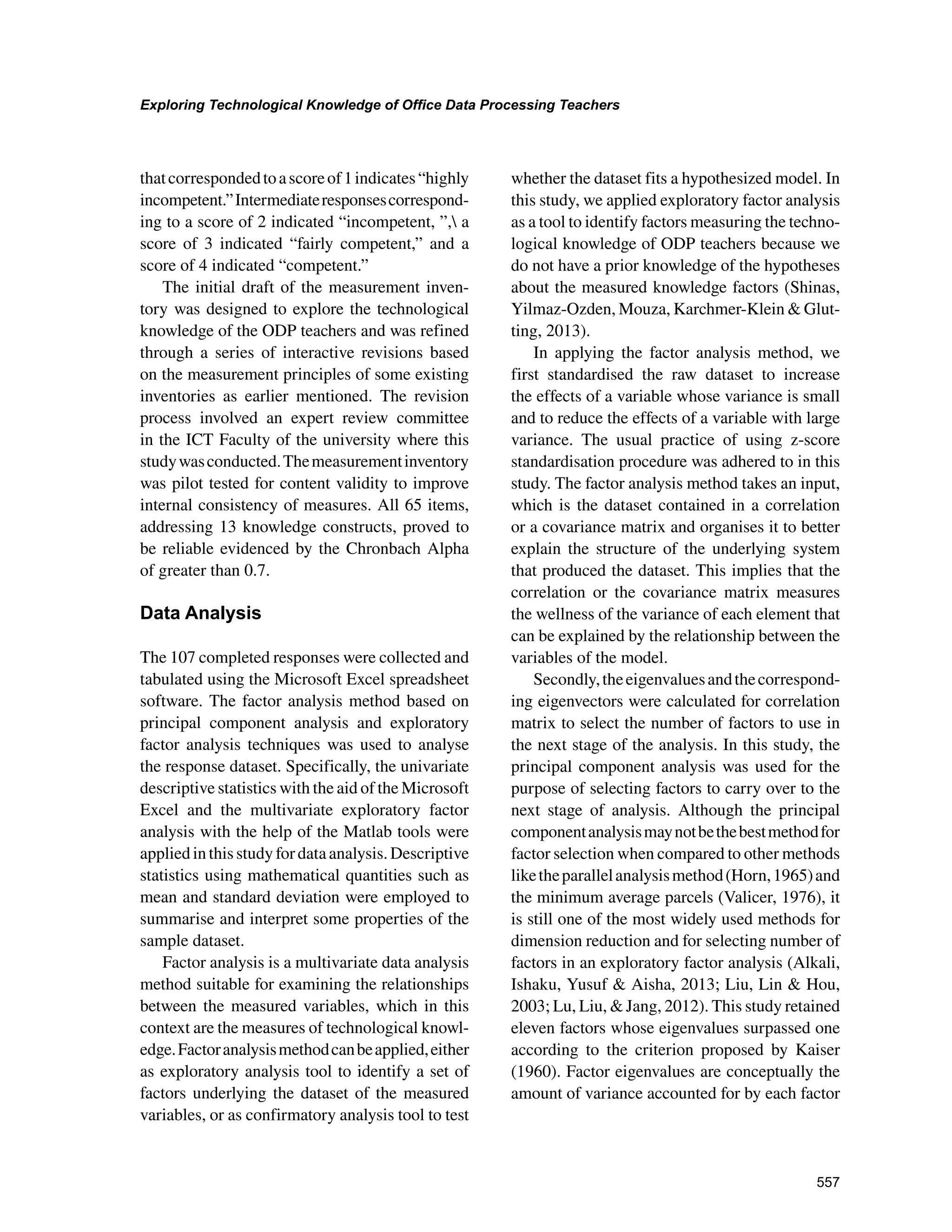
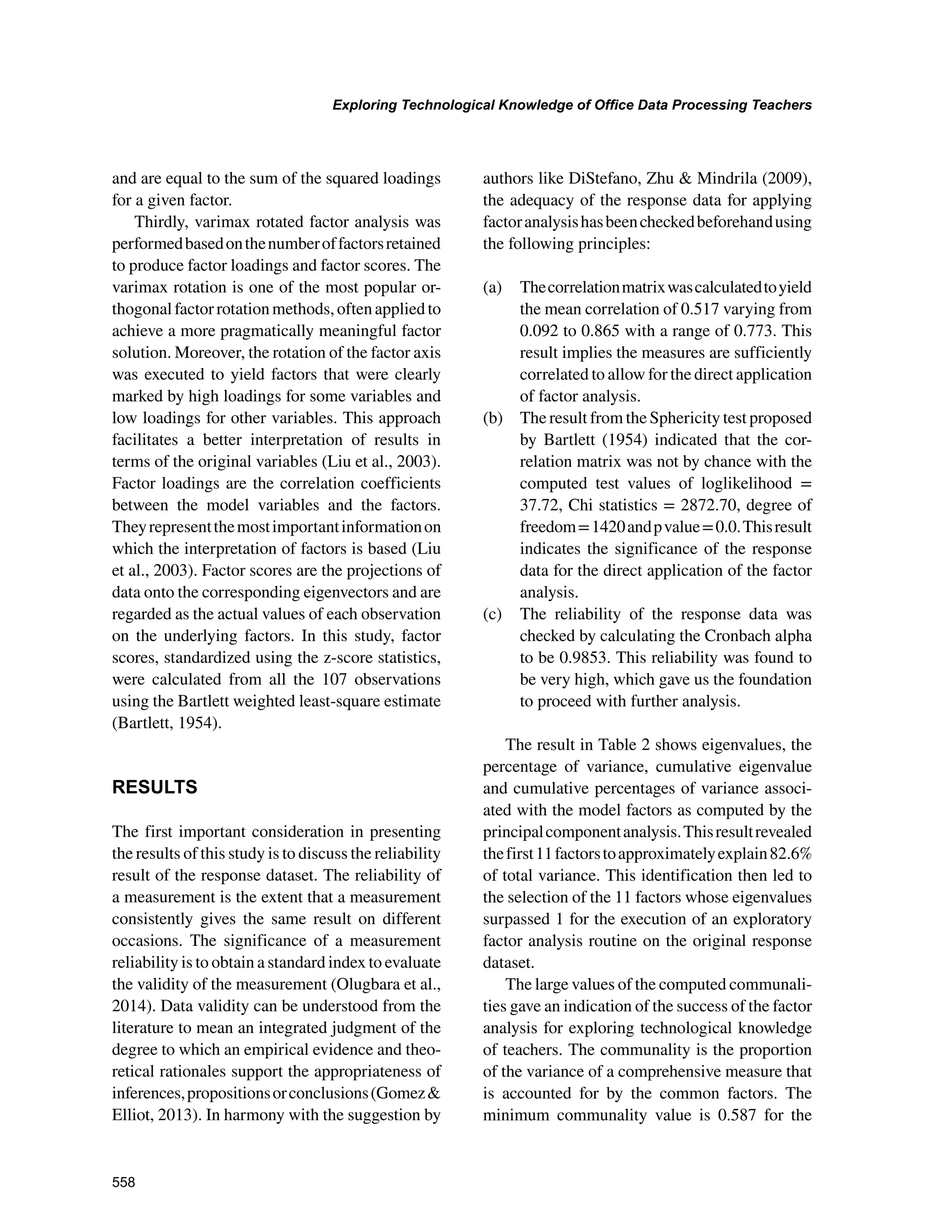
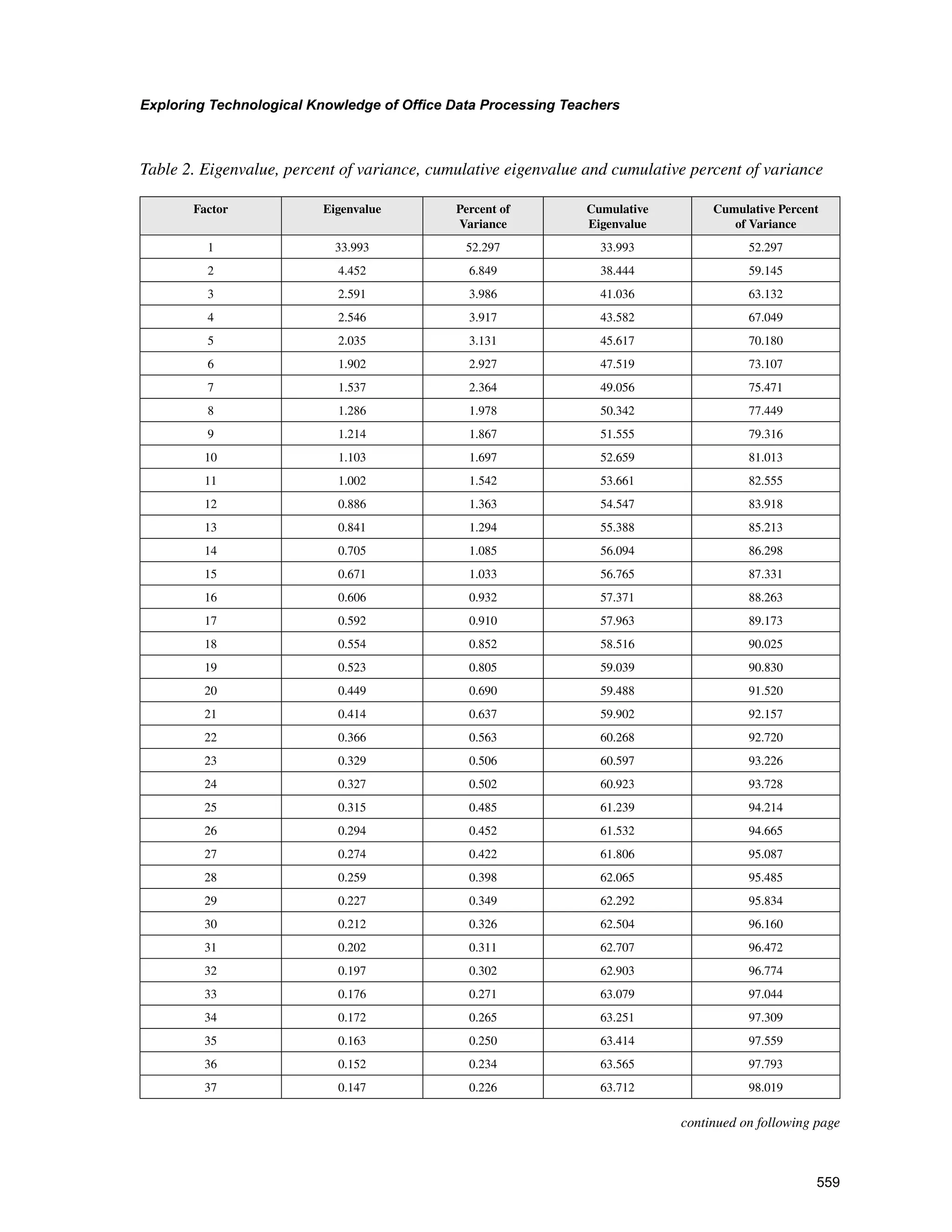

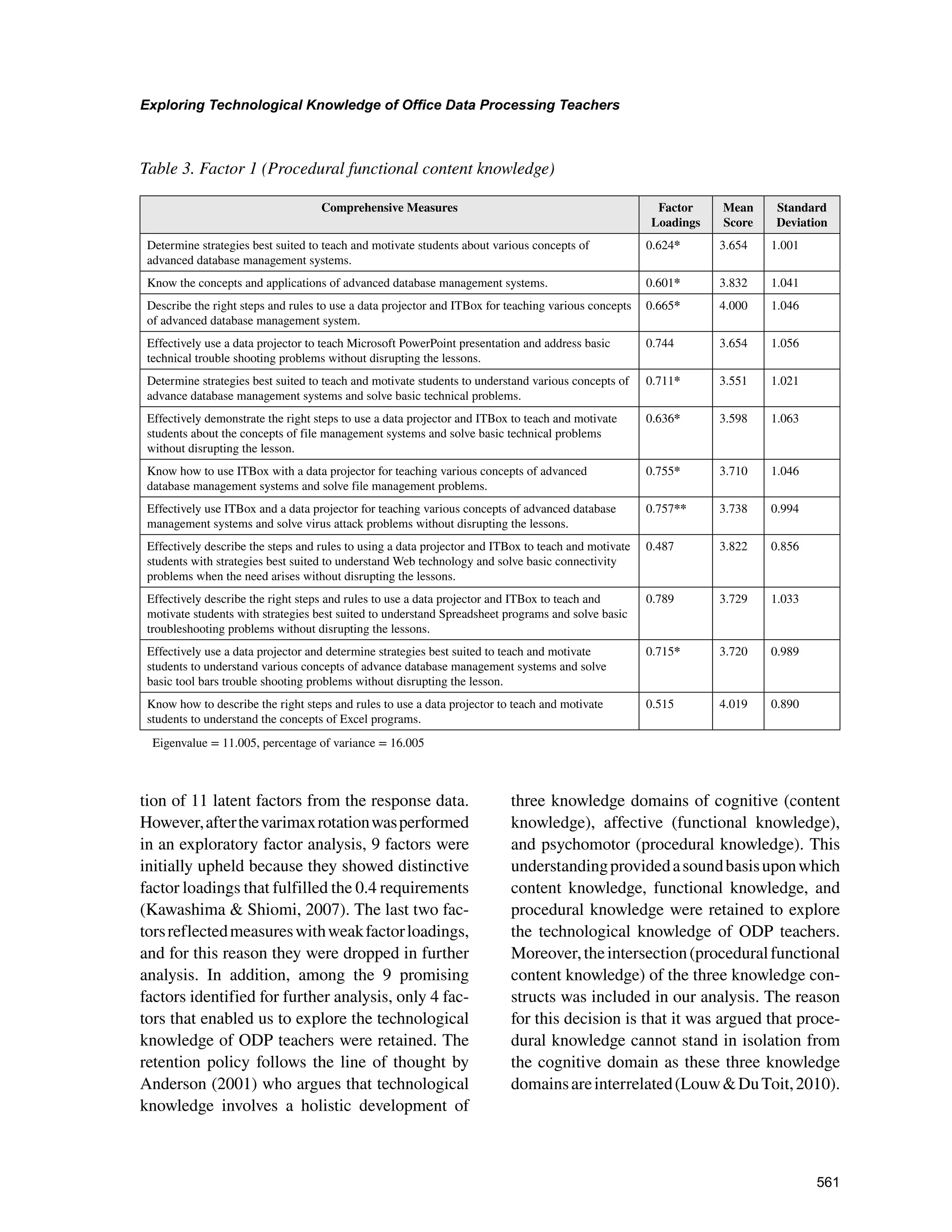
![562
Exploring Technological Knowledge of Office Data Processing Teachers
The surrogate method was used to name the 4
latent factors for technological knowledge explo-
ration as discovered from the exploratory factor
analysis. According to this surrogate method, the
name of a latent factor corresponds to the name
of a single comprehensive measure that loaded
highly amongst all semantically related compre-
hensive measures of the factor. The loadings of
semantically related comprehensive measures
are marked with asterisk (*) and the factor that
loaded highly amongst the semantically related
comprehensive measures is marked with double
asterisk (**). The terms “weak”, “moderate” and
“strong” respectively, refer to the factor loading
values in the interval [0.3, 0.5], [0.5, 0.75] and
[0.75, 1.0] (Liu et al., 2003).
The most important factor, accounting for
16.00% of variance, is factor 1 presented in table
3. There were 12 measures in this factor with
their loadings ranging from 0.487 to 0.757. The
mean scores of the measures of this factor ranged
from 3.551 to 4.019, meaning the ODP teachers
generally responded well above the middle point
of 3. The majority of the measures semantically
referredtotheuseoftechnologytoteachdatabase
management systems. In particular, the measure
with the highest loading (0.757) that belongs to
the knowledge category of procedural functional
Table 4. Factor 2 (Functional knowledge)
Comprehensive Measures Factor
Loadings
Mean
Score
Standard
Deviation
Determine strategies best suited to motivate students to understand various concepts of
spreadsheet programs.
0.724* 4.112 0.805
Know various concepts and application of spreadsheet programs, including Microsoft Excel. 0.636* 4.224 0.793
Know how to describe the right steps and rules to use a data projector to teach the concepts of
formatting worksheets.
0.752** 3.972 0.956
Effectively use a data projector and Interactive Teaching Box (ITBox)to teach Worksheets
Printing and solve all basic printing problems when the need arises.
0.511* 3.850 0.909
Determine strategies best suited to teach students to understand various concepts of file
management programs.
0.552* 3.841 0.943
Effectively demonstrate the right steps to use ITBox and a data projector to motivate students to
understand the concepts of Mail merge and solve basic troubleshooting problems when the need
arises.
0.629* 3.963 0.951
Know how to effectively describe the right steps and procedures to use a data projector to teach
various concepts of Keyboard customization and solve basic technical problems when the need
arises.
0.629* 3.841 1.029
Know how to describe the right steps to use ITBox with a data projector to teach various
concepts of Keyboard customization.
0.619* 3.841 1.083
Know how to effectively use ITBox with a data projector to teach and demonstrate various
concepts of Worksheet formatting and solve basic troubleshooting problems when the need arises
without disrupting the lessons.
0.743* 3.841 0.992
Effectively use a data projector and determine strategies best suited to motivate students
to understand various concepts of Keyboard customization and Toolbar and solve basic
troubleshooting problems when the need arises without disrupting the lessons.
0.634 4.009 0.906
Know how to describe the right steps and rules to use a data projector to teach and motivate
students with strategies to understand Microsoft word processing concepts and solve tool bar
access troubleshooting problems without disrupting the lesson.
0.675 3.925 0.929
Effectively describe the right steps and strategies best suited to use a data projector and ITBox
to teach and motivate students to understand various concepts of spreadsheet programs and solve
trouble shooting problems without disrupting the lesson.
0.709* 3.981 0.879
Eigenvalue = 8.433, percentage of variance = 12.974](https://image.slidesharecdn.com/9fa76cad-d82e-4899-af61-921f328b50bc-170203105159/75/Exploring-Technological-Knowledge-of-Office-Data-Processing-Teachers_-Using-Factor-Analytic-Methods-17-2048.jpg)
